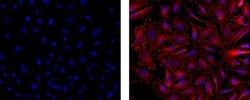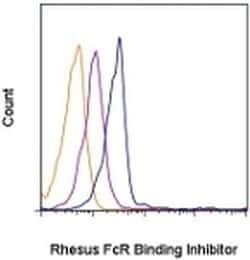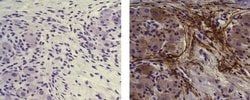50-112-2769
PSA-NCAM Monoclonal Antibody (12E3), eBioscience™, Invitrogen™
Manufacturer: Fischer Scientific
Select a Size
| Pack Size | SKU | Availability | Price |
|---|---|---|---|
| Each of 1 | 50-112-2769-Each-of-1 | In Stock | ₹ 37,380.00 |
50-112-2769 - Each of 1
In Stock
Quantity
1
Base Price: ₹ 37,380.00
GST (18%): ₹ 6,728.40
Total Price: ₹ 44,108.40
Antigen
PSA-NCAM
Classification
Monoclonal
Concentration
0.5 mg/mL
Formulation
PBS with 0.09% sodium azide; pH 7.2
Gene Accession No.
P13591, P13595, P13596
Gene Symbols
NCAM1
Purification Method
Affinity chromatography
Regulatory Status
RUO
Gene ID (Entrez)
17967, 24586, 4684
Content And Storage
4° C
Form
Liquid
Applications
Immunocytochemistry, Immunohistochemistry (Frozen), Immunohistochemistry (Paraffin), Western Blot
Clone
12E3
Conjugate
Unconjugated
Gene
NCAM1
Gene Alias
antigen recognized by monoclonal antibody 5.1H11; CD56; E-NCAM; MSK39; Ncam; N-CAM; NCAM1; N-CAM-1; NCAM-1; NCAMC; NCAM-C; neural cell adhesion molecule 1; neural cell adhesion molecule, NCAM; Polysialylated NCAM; PSA NCAM
Host Species
Mouse
Quantity
100 μg
Primary or Secondary
Primary
Target Species
Human, Mouse, Rat
Product Type
Antibody
Isotype
IgM
Description
- Description: The monoclonal antibody 12E3 specifically recognizes polysialylated neural cell adhesion molecule (PSA-NCAM) in human, mouse and rat
- Polysialic acid is a long homopolymer of sialic acid that is negatively charged and is attached to neural cell adhesion molecule (CD56) and serves as a regulator of NCAM function
- PSA attachment to NCAM is associated with inhibited adhesion of neural cells
- PSA-NCAM expression is highly regulated and corresponds to specific neural developmental windows in which neural precursors are migrating and during the process of axonal sprouting, guidance, and targeting
- PSA-NCAM expression is prevalent during development of the brain, but in the adult becomes restricted to regions undergoing self-renewal or exhibiting plasticity such as the olfactory bulb, suprachiasmatic nucleus, hippocampus, hypothalamus, and specific spinal cord nuclei
- PSA-NCAM is re-expressed during tumorigenesis and is also expressed on cell lines isolated from neuroblastomas and pheochromocytomas
- Applications Reported: This 12E3 antibody has been reported for use in immunohistochemical staining of frozen tissue sections, immunohistochemical staining of formalin-fixed paraffin embedded tissue sections, microscopy, and immunocytochemistry
- Applications Tested: This 12E3 antibody has been tested by immunocytochemistry of formaldehyde-fixed PC-12 (rat) cells and can be used at less than or equal to 20 μg/mL
- Polysialic acid is a long homopolymer of sialic acid that is negatively charged and is attached to neural cell adhesion molecule (CD56) and serves as a regulator of NCAM function
- PSA attachment to NCAM is associated with inhibited adhesion of neural cells
- PSA-NCAM expression is highly regulated and corresponds to specific neural developmental windows in which neural precursors are migrating and during the process of axonal sprouting, guidance, and targeting
- PSA-NCAM expression is prevalent during development of the brain, but in the adult becomes restricted to regions undergoing self-renewal or exhibiting plasticity such as the olfactory bulb, suprachiasmatic nucleus, hippocampus, hypothalamus, and specific spinal cord nuclei
- PSA-NCAM is re-expressed during tumorigenesis and is also expressed on cell lines isolated from neuroblastomas and pheochromocytomas.
Compare Similar Items
Show Difference
Antigen: PSA-NCAM
Classification: Monoclonal
Concentration: 0.5 mg/mL
Formulation: PBS with 0.09% sodium azide; pH 7.2
Gene Accession No.: P13591, P13595, P13596
Gene Symbols: NCAM1
Purification Method: Affinity chromatography
Regulatory Status: RUO
Gene ID (Entrez): 17967, 24586, 4684
Content And Storage: 4° C
Form: Liquid
Applications: Immunocytochemistry, Immunohistochemistry (Frozen), Immunohistochemistry (Paraffin), Western Blot
Clone: 12E3
Conjugate: Unconjugated
Gene: NCAM1
Gene Alias: antigen recognized by monoclonal antibody 5.1H11; CD56; E-NCAM; MSK39; Ncam; N-CAM; NCAM1; N-CAM-1; NCAM-1; NCAMC; NCAM-C; neural cell adhesion molecule 1; neural cell adhesion molecule, NCAM; Polysialylated NCAM; PSA NCAM
Host Species: Mouse
Quantity: 100 μg
Primary or Secondary: Primary
Target Species: Human, Mouse, Rat
Product Type: Antibody
Isotype: IgM
Antigen:
PSA-NCAM
Classification:
Monoclonal
Concentration:
0.5 mg/mL
Formulation:
PBS with 0.09% sodium azide; pH 7.2
Gene Accession No.:
P13591, P13595, P13596
Gene Symbols:
NCAM1
Purification Method:
Affinity chromatography
Regulatory Status:
RUO
Gene ID (Entrez):
17967, 24586, 4684
Content And Storage:
4° C
Form:
Liquid
Applications:
Immunocytochemistry, Immunohistochemistry (Frozen), Immunohistochemistry (Paraffin), Western Blot
Clone:
12E3
Conjugate:
Unconjugated
Gene:
NCAM1
Gene Alias:
antigen recognized by monoclonal antibody 5.1H11; CD56; E-NCAM; MSK39; Ncam; N-CAM; NCAM1; N-CAM-1; NCAM-1; NCAMC; NCAM-C; neural cell adhesion molecule 1; neural cell adhesion molecule, NCAM; Polysialylated NCAM; PSA NCAM
Host Species:
Mouse
Quantity:
100 μg
Primary or Secondary:
Primary
Target Species:
Human, Mouse, Rat
Product Type:
Antibody
Isotype:
IgM
Antigen: Fc Receptor Binding Inhibitor
Classification: __
Concentration: 5 μL/Test
Formulation: PBS with 0.2% BSA and 0.09% sodium azide; pH 7.2
Gene Accession No.: __
Gene Symbols: __
Purification Method: Affinity chromatography
Regulatory Status: RUO
Gene ID (Entrez): __
Content And Storage: 4° C
Form: Liquid
Applications: Flow Cytometry
Clone: __
Conjugate: Unconjugated
Gene: __
Gene Alias: Fc blocking; FcR BI; FcR Inhibitor
Host Species: Rhesus Monkey
Quantity: 100 Tests
Primary or Secondary: Primary
Target Species: Rhesus Monkey
Product Type: __
Isotype: __
Antigen:
Fc Receptor Binding Inhibitor
Classification:
__
Concentration:
5 μL/Test
Formulation:
PBS with 0.2% BSA and 0.09% sodium azide; pH 7.2
Gene Accession No.:
__
Gene Symbols:
__
Purification Method:
Affinity chromatography
Regulatory Status:
RUO
Gene ID (Entrez):
__
Content And Storage:
4° C
Form:
Liquid
Applications:
Flow Cytometry
Clone:
__
Conjugate:
Unconjugated
Gene:
__
Gene Alias:
Fc blocking; FcR BI; FcR Inhibitor
Host Species:
Rhesus Monkey
Quantity:
100 Tests
Primary or Secondary:
Primary
Target Species:
Rhesus Monkey
Product Type:
__
Isotype:
__
Antigen: Estrogen Receptor beta
Classification: Monoclonal
Concentration: 0.5 mg/mL
Formulation: PBS with 0.09% sodium azide; pH 7.2
Gene Accession No.: Q92731
Gene Symbols: ESR2
Purification Method: Affinity chromatography
Regulatory Status: RUO
Gene ID (Entrez): 2100
Content And Storage: 4° C
Form: Liquid
Applications: ELISA, Immunocytochemistry, Immunohistochemistry (Paraffin), Immunoprecipitation, Western Blot
Clone: MC10
Conjugate: Unconjugated
Gene: ESR2
Gene Alias: ER; ER beta; ER[b]; Erb; Erb2; Erbeta; ER-beta; Esr2; ESRB; ESR-BETA; ESTRB; estrogen receptor 2; estrogen receptor 2 (beta); estrogen receptor 2 (ER beta); estrogen receptor 2 beta; estrogen receptor beta; estrogen receptor beta 1 isoform deletion variant; estrogen receptor beta 4; NR3A2; Nuclear receptor subfamily 3 group A member 2; oestrogen receptor beta; steroid receptor
Host Species: Mouse
Quantity: 100 μg
Primary or Secondary: Primary
Target Species: Human
Product Type: Antibody
Isotype: IgG2a κ
Antigen:
Estrogen Receptor beta
Classification:
Monoclonal
Concentration:
0.5 mg/mL
Formulation:
PBS with 0.09% sodium azide; pH 7.2
Gene Accession No.:
Q92731
Gene Symbols:
ESR2
Purification Method:
Affinity chromatography
Regulatory Status:
RUO
Gene ID (Entrez):
2100
Content And Storage:
4° C
Form:
Liquid
Applications:
ELISA, Immunocytochemistry, Immunohistochemistry (Paraffin), Immunoprecipitation, Western Blot
Clone:
MC10
Conjugate:
Unconjugated
Gene:
ESR2
Gene Alias:
ER; ER beta; ER[b]; Erb; Erb2; Erbeta; ER-beta; Esr2; ESRB; ESR-BETA; ESTRB; estrogen receptor 2; estrogen receptor 2 (beta); estrogen receptor 2 (ER beta); estrogen receptor 2 beta; estrogen receptor beta; estrogen receptor beta 1 isoform deletion variant; estrogen receptor beta 4; NR3A2; Nuclear receptor subfamily 3 group A member 2; oestrogen receptor beta; steroid receptor
Host Species:
Mouse
Quantity:
100 μg
Primary or Secondary:
Primary
Target Species:
Human
Product Type:
Antibody
Isotype:
IgG2a κ
Antigen: CD271 (NGF Receptor)
Classification: Monoclonal
Concentration: 0.5 mg/mL
Formulation: PBS with 0.09% sodium azide; pH 7.2
Gene Accession No.: P07174, P08138, Q9Z0W1
Gene Symbols: Ngfr
Purification Method: Affinity chromatography
Regulatory Status: RUO
Gene ID (Entrez): 100349095, 100525607, 101119064, 18053, 24596, 4804, 491071
Content And Storage: 4° C
Form: Liquid
Applications: Flow Cytometry, Immunocytochemistry, Immunohistochemistry (Paraffin), Western Blot
Clone: ME20.4
Conjugate: Unconjugated
Gene: Ngfr
Gene Alias: CD271; CD271 antigen; Gp80-LNGFR; LNGFR; low affinity nerve growth factor receptor; low affinity neurotrophin receptor p75NTR; LOW QUALITY PROTEIN: tumor necrosis factor receptor superfamily member 16; low-affinity nerve growth factor receptor; nerve growth factor receptor; nerve growth factor receptor (TNFR superfamily, member 16); nerve growth factor receptor, fast; NGF receptor; NGFR; NGR; p75; p-75; p75 ICD; p75 neurotrophin receptor; p75 ntr; p75(NTR); p75NGFR; p75NTR; RNNGFRR; TNFR superfamily, member 16; Tnfrsf16; TNR16; Tumor necrosis factor receptor superfamily member 16
Host Species: Mouse
Quantity: 100 μg
Primary or Secondary: Primary
Target Species: Canine, Human, Mouse, Non-human Primate, Ovine, Porcine, Rabbit, Rat
Product Type: Antibody
Isotype: IgG1 κ
Antigen:
CD271 (NGF Receptor)
Classification:
Monoclonal
Concentration:
0.5 mg/mL
Formulation:
PBS with 0.09% sodium azide; pH 7.2
Gene Accession No.:
P07174, P08138, Q9Z0W1
Gene Symbols:
Ngfr
Purification Method:
Affinity chromatography
Regulatory Status:
RUO
Gene ID (Entrez):
100349095, 100525607, 101119064, 18053, 24596, 4804, 491071
Content And Storage:
4° C
Form:
Liquid
Applications:
Flow Cytometry, Immunocytochemistry, Immunohistochemistry (Paraffin), Western Blot
Clone:
ME20.4
Conjugate:
Unconjugated
Gene:
Ngfr
Gene Alias:
CD271; CD271 antigen; Gp80-LNGFR; LNGFR; low affinity nerve growth factor receptor; low affinity neurotrophin receptor p75NTR; LOW QUALITY PROTEIN: tumor necrosis factor receptor superfamily member 16; low-affinity nerve growth factor receptor; nerve growth factor receptor; nerve growth factor receptor (TNFR superfamily, member 16); nerve growth factor receptor, fast; NGF receptor; NGFR; NGR; p75; p-75; p75 ICD; p75 neurotrophin receptor; p75 ntr; p75(NTR); p75NGFR; p75NTR; RNNGFRR; TNFR superfamily, member 16; Tnfrsf16; TNR16; Tumor necrosis factor receptor superfamily member 16
Host Species:
Mouse
Quantity:
100 μg
Primary or Secondary:
Primary
Target Species:
Canine, Human, Mouse, Non-human Primate, Ovine, Porcine, Rabbit, Rat
Product Type:
Antibody
Isotype:
IgG1 κ






